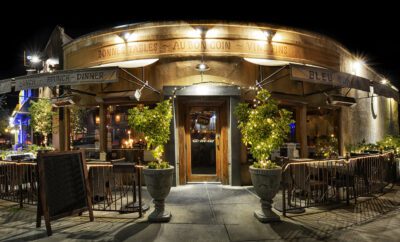Lifestyle
San Diego, Home of Taylor Guitars
Since 1974 Taylor Guitars has called San Diego home. Quaintly tucked away in its El Cajon location the warehouse has not only become a monument to outstanding guitar products but also a reflection of the great city of San Diego.
Founded in 1974 by Bob Taylor and Kurt Listug, it originally started in Lemon Grove, CA. Soon after its conception they decided to move to El Cajon and planted the seeds for what is now Taylor Guitars. The facility in El Cajon is the main facility for all Taylor products, it is 145,000 square feet, and is a resounding account to Taylor’s success in the music industry. Other than the sister company in Tecate, Mexico, which manufactures “Baby Taylors” and the one hundred and two hundred series guitars. The El Cajon location is the main production point for all of Taylor Guitars throughout the world.
The Entertainer had a chance to catch up with Chalise Zolezzi and get an astounding walk through of the amazing facility located right here in the heart of San Diego.
When a company lays its foundation in an area, it often leaves its mark in numerous ways. Whether it is providing jobs for the community, outreach programs, contributing to schools, and many other forms of aid, the business becomes a participant in that social society, and Taylor Guitars plays just that role.

Photo from Bruno Correa via Flickr
“Taylor Guitars for Schools is our main beneficiary. Through TGS and along with the San Diego Music Foundation, we work to place guitars in schools for music classes.” Chalise mentions walking into the facility. Taylor has not only become part of the community but has an active role in many programs outside of the company. “We’re involved in Build a Future Concert, East County Economic Development Council where we work with schools to keep their industrial art programs alive.” It is apparent that Taylor cares about the community that has supported it for over 35 years, and is paying back the dividends for that devotion.
Despite the economic downturn our nation has taken in the recent years, Taylor has still managed to keep its head above the water. Has this ability risen from a well-oiled machine, or is it due to the beauty that Taylor Guitars make that speaks to our soul when each string is plucked? One may never know. But there is something that economists cannot theorize on when it comes to the growing numbers in the company.
They need a place to lie their heads down and let go of all their worries and woes. There is nothing better to provide that than a finely tuned Taylor Guitar. It is the quality of escape that has aided Taylor in its success through the turmoil of the US and world economy.
If music helps business stay afloat then all music manufacturers should be booming in the recession, right? Wrong. The only reason Taylor has stayed on top of the spiraling economy is due to their outstanding craftsmanship and detail in making every single guitar unique and a cut above the rest.
The process that goes on in the 145,00 square foot facility is what puts Taylor Guitars on the map. The attention to detail and precision of each and every individual model is uncanny, and is the reason Taylor is a leader in the industry.
The 145,00 square foot facility has three warehouses and each one is dedicated to a unique process of the making of a Taylor guitar. The first warehouse is the fitting and building of the body of the guitar. Sides are picked, and painstakingly chosen to the highest degree of standards. Once the criteria have been met, the wood will go onto a machine and ” a computer program will run a laser and cut out the guitar back,” Zolezzi states. The wood that is used by Taylor is even made of great pieces of lumber.
“We use a lot of Rosewoods, Indian Rosewoods probably one, our tops are primarily Sitka Spruce, some Maple, Coco Bolo and much more. “Zolezzi remarks, as she shows each piece of wood. It is clear that Taylor knows that the beginning of a great guitar starts with its wood, and how it is crafted. From the first points of the process the guitar is geared towards perfection and prestige.
As we moved on from the laser room, we moved into the Rosette Room where they fit in linings, which are abalone shell pieces harvested from Australia. Ken on the outside of the opening of the guitar was placing the linings where most of the sound resonates. Showing us the process, it was obvious Ken knew a lot about what he was doing and was very meticulous in his part of the process.
After we left the first facility it was becoming increasingly clear why Taylor is leading in its field. Its accolades in the guitar process are stringent are a very high degree of structure and guidelines. Even when the woods arrive according to Zolezzi “they have to acclimate the wood to El Cajon’s weather.”
Measures like the one above make Taylor Guitars the best, and will always remain the best as time slowly churns forward.
The second warehouse was next on the agenda. Here the neck, and body were put together and fitted for the guitar, here is where everything started to come together. The necks where placed into a machine and cut out to exact specifications that were punched into the machine. Each neck has a trust rod running through it and was given the utmost attention in the process. After the necks are done they are inlaid with unique individual fret pieces set to each specific guitar and model.
Next the guitar edges are molded and according to Zolezzi the process is “a relatively new process that takes from old Luthiers, which they used heat and steam a lot.”
She says it works similarly to “what a curling iron does. It heats the wood and holds it in place, and shapes it.” This is how the guitar sides are shaped to the S-curvature we all know they have. Once the sides are molded in the heat machines they are placed together and make the body. After the body is glued together, kerfing is placed. The kerfing “increases surface space and tonal properties,” for the guitar according to Zolezzi.
Finally after all the components of the guitar are put together it goes into the third factory where the electronics are inlaid into the Guitar. They use a revolutionary electronic system known as the expression system. Rubert Neve, who is a genius when it comes to amplification and audio, created the expression system. According to Zolezzi the expression system “is a series of body sensors that are located on the top of the guitar, the magnets capture the movement of the top and amplify it.” Neve is a revolutionary when it comes to amplification techniques, and to have his design that was developed in partnership with Taylor Guitars only makes them that much more powerful.
All in all, it is clear that Taylor Guitars is a shining example of exemplary guitar creations. It’s location in El Cajon and San Diego, makes it a beacon for the city and the people within it. We should be proud that such a foundation and leader in a huge field sleeps under the same stars that we do. Their process of creation is unlike any other and has earned our devotion and love, and no one can take that away from them.





1 Comment